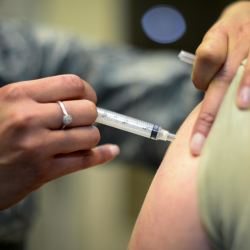The media trope “if it bleeds, it leads” is at play in undermining accurate messages with respect to the status of vaccine compliance. A fear-based technique intended to capture the audience by news outlets is, sadly, a tried-and-true one. Content will change, but the story design to lure you in, via concern or alarm, so you might find the antidote to your worries within the piece is alive and well and doing a disservice to public health. Consider a sampling of recent headlines about the just released Centers for Disease Control and Prevention (CDC) report on vaccine coverage and exemption rates:
Cherry-picking and highlighting the tiny fraction of exempt children or “skyrocketed” numbers without vaccination not only doesn’t tell the whole story, but also creates a dubious framework.
And this can do meaningful, tangible harm.
Barely any press address that the CDC review demonstrated, in the 2017–2018 school year, the median kindergarten vaccination coverage was close to 95% for MMR, DTaP and varicella vaccines with the number of states with coverage ≥95% increasing since the prior year. Due to certain limitations in the project, these values might even be underestimated. If the published accounts do mention that the trend in un- or under-vaccinated is small and not a cause for panic, then the concept is buried well into the piece.
Consistently throughout the CDC document was mention of the strong vaccination numbers with an expected caution to want to improve them even further. For example, “Vaccination coverage among kindergartners remained high” is tough to find in social media. The reality is much of the requirements and programs implemented by schools and at the state and local levels are working to enhance vaccination and need to be encouraged, but as previously discussed here, there are hot spots that could be more effectively targeted to increase compliance. And, more work needs to be done.
It is rare that national, one-size-fits-all blanket health policies do much to put a dent in disease burden (see here). This issue is no different.
Recognizing that the “percentage of children reaching age 2 years without having received any vaccinations has increased gradually, from 0.9% for children born in 2011 to 1.3% for children born in 2015” is important. But, so is the context. Stating so matters. As does the fact there were limitations to the CDC’s data collection and what can be interpreted.
Terrifying people unnecessarily is not good policy. Over-hyping one data point in a complex scenario benefits no one. Appreciating the trend is going in the wrong direction is important in identifying locations that can be efficiently and strategically approached, but does not tell the entire story.
When what is absent carries equal or more weight than what is reported, the damage goes beyond ratings. It undermines public health. Only when a truly comprehensive picture is known can it be properly understood – especially in the medical realm. Then, solutions to actual problems that exist can be formulated and implemented.
Describing what is, nothing more and nothing less, is the optimal way to achieve ideal vaccine rates. Being measured may not be the sexiest in storytelling, but it is definitely more honest.

